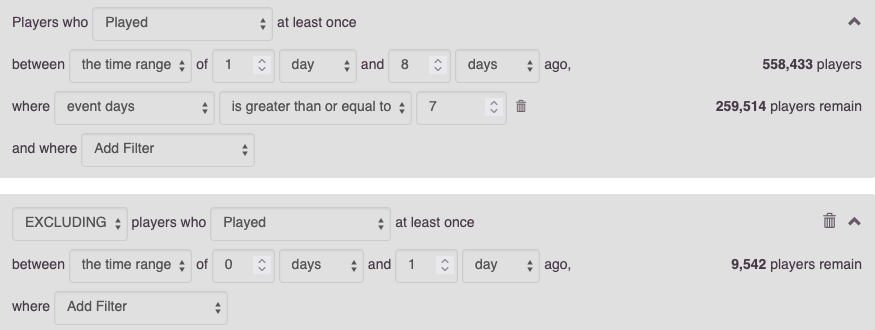
Player churn. It’s the bane of a free-to-play gaming CRM’s job. It’s the reason we started Teak: to help you combat it! At the end of the day, it happens: players leave games and we don’t always get to know exactly why.
However, we’ve spent a lot of time in our article series talking about strategy for personalizing rewards, making your push notifications engaging, how to A/B test like a pro, and the best way to manage recurring sends. These are all things that will help you fight churn and keep players coming back. But we haven’t quite explored the reasons players leave games to begin with. What are the driving factors? And what can we learn from them?

There are some big reasons for churn that game developers always think about, like poor onboarding and short attention spans. Therefore, every studio is putting resources into trying to improve that first impression, and bumping your game to the top of the attention stack is the CRM’s first job.
But, what about the reasons for churn that don’t get as much attention? Today, we’ll get into the top 3 overlooked reasons we see players leave games, focusing specifically on the ones that a CRM can directly address through strategy and best practices. Let’s get into it!
The First Overlooked Reason Players Quit Free-to-Play Games…
At Teak, we’ve seen game designers who think about this issue, but only the cleverest CRMs consider how they can make an impact: Players who churn when it becomes too hard to progress.
When a player becomes stuck on a level or in a loop, there is no incentive to keep playing. They can’t reach new levels, they can’t unlock new features, and the game becomes stale and frustrating. As a games CRM, your number one goal is to keep players coming back for more and more sessions, and ideally longer sessions. So what can we do?
The best way to combat this from the CRM side is to build it into your rewarding strategy. This is where our advice about Core and Risk players comes in: If a player has stalled out, consider giving them more coins than normal. That reward could be just enough to get them over the hump they are considering “too difficult.” The amount of coins you give away to players is already a big part of what keeps them playing - and can also be the reason they don’t give up when stuck.
In order to make this approach work though, remember that rewards are something that should be treated as very specific to the group of players you’re targeting. We have a guide to personalizing push notifications that gets into the reward pieces of it right here. The amount of coins or bonuses it takes to unlock the next play will vary depending on the audience.
The Second Overlooked Reason Players Quit? Not Enough to Do
The second reason players leave your game will likely be because there isn’t enough to do in the game itself. This isn’t necessarily on the CRM’s shoulders, and is much more related to game development and analytics.
However, something you should consider as a CRM that’s well within your control is: are you sharing enough about what you can do in your game? Are your push notifications highlighting new features? Do you have a calendar of upcoming events that you track against for messaging priorities? Make sure players know what’s new and exciting in your game.
Additionally, are there underexplored parts of the game you could highlight? If you have a backlog of old content, rotate through it. You can rerun events you haven’t run in a while, maybe with a mild art refresh. If you have lots of live content (a variety of slot machines, zones in an MMO, etc.), highlight a different piece of content each week in your messaging.
And Number Three: Messaging Strategy
The last overlooked reason we see players churn is the messaging strategy isn’t resonating, causing people to be annoyed or frustrated by the notifications. It’s more effort, and more taps on a phone, to unsubscribe from push notifications than to simply uninstall a game.
If you’re sending a high amount of irrelevant or uninteresting notifications, someone might be prompted to simply delete the game. Always ensure that you are reevaluating your messaging strategy and looking for holes or repetition. Reengagement content is especially important here since a player who hasn’t played in a while is more likely to uninstall.
We have some tips on reengagement content here, but the primary points you’ll want to focus on are highlighting what’s new and exciting, keeping the player’s day in mind, and the number one thing: no begging! A desperate notification will drive players away faster than almost any other kind. Instead of “We Miss You!”, think about it as “We Added 5 New Slot Machines! Try Them Out With 50,000 Coins On Us.”
Can You Predict a Player is About to Quit?
While there is no magical crystal ball that can tell you when a player is going to leave a game, there are some indicators that you can look out for.
The biggest sign a player might be churning is they go from playing daily to missing a day or two. This could be because of the player’s own habits, and not one of the factors listed above. It’s difficult to keep a daily play cadence when life gets in the way! For example, it could also be a holiday season (and we’ve covered bringing players back after the holidays here). But whatever the reason, it’s a pretty strong sign and a good thing to track so you can ideally get ahead of churn.
This ties into our Risk messaging strategy and is a major reason why it’s important to give the player an extra notification when you start to see their gameplay dip.
In Teak, you can specifically target “players who play daily but just missed a day” and use a triggered schedule to immediately give them an extra nudge. Curious how exactly to set that up? Shoot us an email and we’ll help!

Use the Audience builder to set up an audience of daily players who didn’t play yesterday.
Churn Happens
The fact of the matter is, churn happens, and players are going to leave your game no matter what. It’s part of the Player Lifecycle and it’s natural. But, with the insights from above (and some of the learnings we share on our blog) you can reduce that churn by more and more each month. You can also bring in new players each month, adding to the reduction in churn and getting new downloads onboard.
Like we said at the start, Teak was built to fight churn and be your partner in this journey. Let us know what we can do to help! We are here to answer any questions you have.
Alex, Erica, and the Teak Team